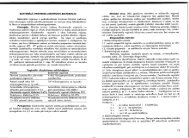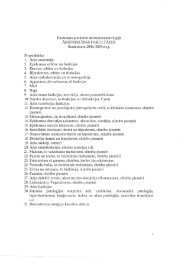PHYSICS
n - susliks.lv
n - susliks.lv
- No tags were found...
You also want an ePaper? Increase the reach of your titles
YUMPU automatically turns print PDFs into web optimized ePapers that Google loves.
to regions of low concentration. All plants utilize water as a solvent;<br />
therefore, osmosis for plant cells means the diffusion of<br />
water through a semi permeable membrane. In order to reach a<br />
state of equilibrium, it is necessary to apply to the solution a<br />
pressure which is equivalent to osmotic pressure of solution. If<br />
water diffuses into the vacuole, its volume will be increased, increasing<br />
the outward pressure on the cell wall. The pressure exerted<br />
on the cell wall which is called turgor pressure (Pr)' At the<br />
same time, the cell wall opposes the pressure of the cytoplasm.<br />
The condition of equilibrium can be written in as:<br />
Pr - P~sm = - P;sm (6.6)<br />
where P~sm and P;sm are the osmotic pressures within and outside<br />
of the cell.<br />
Osmotic pressure plays an important role in phloem transport<br />
in plants and is the driving force in cell elongation during growth.<br />
-<br />
VI<br />
I<br />
v.....<br />
Fig. 6.4. Flow through<br />
a tube of varying<br />
cross-sectional area<br />
50<br />
6.2. FLUID DYNAMICS<br />
6.2.1. The Continuity Equation<br />
This section deals initially with a model of an ideal fluid which<br />
is considered to be non viscous and incompressible. Consider a fluid<br />
flowing through a pi pe of nonuniform size as in fig. 6.4. An incompressible<br />
fluid moving with steady flow through a pipe of varying<br />
cross-sectional area is described by the equation of continuity:<br />
S)' VI = S2' V 2<br />
(6.7)<br />
~<br />
+<br />
That is, the product of the area<br />
and the fluid speed at all points<br />
along the pipe is a constant. This<br />
equation can be written as:<br />
s = const<br />
V<br />
(6.8)<br />
hI<br />
h 2<br />
6.2.2. Bernoulli's Equation<br />
Consider a situation where the height of the tube above some<br />
reference level also changes (fig. 6.5). Bernoulli's equation states<br />
that the sum of the static pressure (P), the hydrodynamic pressure<br />
pV' (i.e., the kinetic energy per unit volume), and hydrostaticplessure<br />
(pgh) (i.e., the potential energy per unit volume) has<br />
the same value at all points along a streamline:<br />
V<br />
p+p.g.h+~=const, 2<br />
2<br />
(6.9)<br />
where p is the static pressure, p·g·h is the hydrostatic pressure,<br />
and p. v 2 is the dynamic pressure of the fluid.<br />
2 In most problems of biological<br />
interest, h = const, and Bernoulli's<br />
equation becomes:<br />
V 2<br />
p + P ._ = const (6.10)<br />
Fig. 6.5. Flow through a tube of varying<br />
cross-sectional area; the heights of the tube<br />
above some reference level are different<br />
6.2.3. Medical Application of Bernoulli's Equation<br />
Trombosis. The appearance of clots in the blood vessels or the<br />
accumulation of plaque on the inner walls leads to a disease<br />
called trombosis. This situation is accompanied by the constriction<br />
of the vessel (fig. 6.6). If the cross-sectional area of the vessel<br />
decreases, the fluid speed must be increased [see equation (6.8)].<br />
As the speed increases with decreasing area, equations (6.5) and<br />
(6.7) imply that the dynamic<br />
DC]<br />
pressure also increases, but<br />
the static pressure, in order<br />
to maintain a constant flow<br />
Fig. 6.6. Constriction of blood<br />
vessel due to trombosis<br />
51






